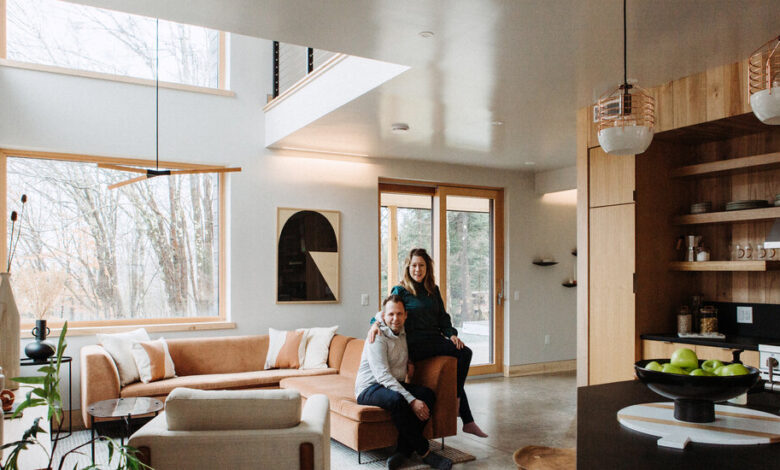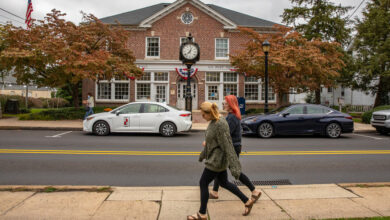Developers Build More Net Zero Homes as Climate Concerns Grow

[ad_1]
In the three years that Nicole Rae and Brian Mastenbrook lived in the San Francisco Bay Area, they grew increasingly concerned about California’s wildfires. The skies would turn orange, ash would settle on plants and porch railings, and Ms. Rae, a 30-year-old teacher who has asthma, would have trouble breathing.
So in May, she and Mr. Mastenbrook, a 37-year-old tech worker, sold their home and moved to Ann Arbor, Mich. Mr. Mastenbrook has family in Michigan, and officials in Ann Arbor were taking steps to lower the city’s carbon footprint.
They admired plans for a “net zero” community there, Veridian at County Farm, to be filled with solar-powered, all-electric homes that would be free of the fossil fuels whose greenhouse gas emissions have contributed to climate change.
“If those homes were built and ready to buy today,” Ms. Rae said, “we already would have purchased one.”
The couple’s experience as climate refugees may be dramatic, but across the country, more home buyers are seeking net zero residences, so called because they produce as much energy as they consume and, because they typically achieve this via solar power, do not add carbon to the atmosphere. And developers are increasingly stepping up to meet the demand.
Data on net zero housing is scarce, but a report from the nonprofit group Team Zero tallies about 24,500 homes in the United States that achieve “zero energy” performance and estimates that the actual number “is considerably larger.” The Department of Energy has certified 8,656 as “net zero ready,” meaning they could reach zero energy with the addition of solar.
The numbers are expected to grow, spurred not only by consumer appetite but also by building code updates, more affordable solar technology, a growing familiarity with once-exotic appliances like induction stoves and the “electrify everything” movement. Now investors are increasingly steering money toward sustainable real estate, making it easier for developers to raise money for housing that addresses climate concerns.
And although the net zero movement is sometimes associated with homes for the affluent, it is also resulting in housing for those at the other end of the income spectrum, who stand to benefit from lower energy bills.
“The housing industry is being disrupted the way the auto industry was,” said Aaron Smith, chief executive of the nonprofit Energy & Environmental Building Alliance, referring to the popularity of electric cars and pledges by manufacturers to phase out gasoline-powered vehicles.
But even as the climate crisis has highlighted the need for sustainable construction, challenges remain. The building industry has resisted code changes. The surge in demand for single-family homes spurred by the pandemic may weaken the urgency for change because conventional houses are finding ready buyers these days.
Many consumers are still more interested in granite kitchen counters and other cosmetic details than in electric heat pumps, but surveys indicate that millennials are likely to bring their concerns about the environment to their home-buying decisions, said Sara Gutterman, chief executive of Green Builder Media, which has conducted surveys of this demographic group.
Jan Sehrt, 37, and his wife, Julie, 39, both Google workers with a three-bedroom condominium in Brooklyn, spent the better part of the pandemic searching for a second home where they could enjoy nature with their two daughters.
After scouring more than 1,000 listings online, the Sehrts settled on a solar-powered, all-electric house in the Catskill Project, a net zero development in the upstate New York hamlet of Livingston Manor. Their home — which will cost about $1 million and is expected to be completed next fall — will be one of 11 single-family residences designed to maximize solar power and prevent energy loss through airtight building envelopes.
“We stepped into the model home, and they said, ‘These are triple-pane windows,’” said Mr. Sehrt, who was familiar with green building from his childhood in Germany. “After that it was just one win after another.”
There is widespread agreement that residential buildings are crucial to limiting global temperature rise to 1.5 degrees Celsius over preindustrial levels. Buildings, including their construction, account for about 40 percent of carbon emissions, with housing responsible for about half that. Retrofitting inefficient structures is the biggest challenge, but building sustainable homes is also important.
For decades, homeowners experimented with solar panels and off-the-grid houses. Then pioneering developments began cropping up. Grow Community, on Washington State’s Bainbridge Island, introduced its first solar-powered homes in 2012; its third and final phase of development is about to get underway.
Marja Williams, a development consultant who helped guide Grow in its early years and has lived there since 2014, said her monthly utility bill was just $7.97 — the basic service fee. Her house produces more energy than it uses, with the utility funneling off excess power in summer and crediting her account in winter when the solar arrays are less productive. A Grow home that originally cost about $480,000 sold recently for nearly double that, she said.
Builders such as Mandalay Homes and Thrive Home Builders have specialized in homes with ultra-efficient energy use. Others are experimenting with net zero construction.
Crown Pointe Estates recently introduced what may be the most upscale version: the “zero series” homes at the company’s MariSol Malibu development in Ventura County, Calif. The first residence, more than 14,000 square feet, is on the market for $32 million.
Ranging from $384,000 to $681,000, they cost about 10 percent more than neighboring homes but are expected to generate and store all the energy residents need, freeing them from energy bills and vulnerability to blackouts.
About 1,400 people expressed interest in the 11 homes, said Brian Kingston, chief executive of Brookfield’s real estate group, who interpreted that as “proof of concept.” The development team plans to build 200 more like them.
Low-rise, single-family homes are not the only kind of net zero housing in the works: Multifamily housing contains the majority of net zero units in the United States. Sustainable Living Innovations, a Seattle tech company, is building a 15-story, 112-unit apartment tower with factory-made panels preloaded with plumbing, electrical wiring and mechanical systems.
A prefabricated approach is being used on a much smaller scale elsewhere in Seattle: The Block Project is building micro solar homes for the homeless.
The effort, by the nonprofit group Facing Homelessness, crafts panels in a workshop and then assembles them in the yards of homeowners who have agreed to turn over part of their property to a 230-square-foot residence for someone in need. So far, 11 of these homes, which cost about $75,000 to build, are occupied, and more are in the works, said Bernard Troyer, project manager at Facing Homelessness.
Veridian, the Ann Arbor project, aims for a mix of income levels on its 14-acre site. Avalon Housing, a nonprofit provider of affordable housing, will construct nine buildings containing 50 apartments on a portion of the site.
The 110 units of market-rate housing, to be developed by Thrive Collaborative (which is unrelated to Thrive Home Builders), will range from $200,000 apartments to $900,000 single-family homes. Work on the site is expected to begin this fall, and the market-rate homes should be completed in 2023, said Matthew Grocoff, Thrive’s founder.
In addition to securing financing from mission-driven funds, Mr. Grocoff has attracted local investors, among them Mitch and Lori Hall. Retirees with three grown children, the Halls have decided not only to buy a townhouse at Veridian but to become the largest equity partner in the project.
“It’s the way we need to move as a planet and a country,” Ms. Hall said. “Hopefully, 30 years from now, it won’t be so unusual.”
[ad_2]
Source link






